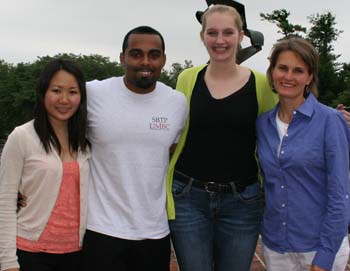
Sometimes science uncovers a pretty interesting “what” long before researchers learn that particular “what’s” equally interesting “how.”
Two Kalamazoo College alumnae are among the authors of a recently published paper describing HOW certain fish change their eyes to see more effectively in different water environments. Such a shift in visual acuity is a pretty cool “what” that’s been known for a while. Even some of the “how” had been elucidated–like knowing the components of a room’s light switch for example. What had been unknown–until now–was the enzyme responsible for the change, or, in other words, the finger that flips the switch.
The two co-authors who share K science ancestry, so to speak, are Rina Fujiwara ’15 and Leslie Nagy ’09. Both did the research described in the paper while working in the laboratory of Fred Guengerich at Vanderbilt University. Guengerich happens to have been the thesis advisor of Laura Furge, the Roger F. and Harriet G. Varney Professor of Chemistry at Kalamazoo College, when Laura was earning her Ph.D. at Vanderbilt. Both Nagy and Fujiwara worked in the Furge Lab during their undergraduate years; talk about scientific ancestry! The paper–titled “Cyp27c1 Red-Shifts the Spectral Sensitivity of Photoreceptors by Converting Vitamin A1 into A2”–appeared this week in the high impact scientific journal Current Biology. The Atlantic also published an article on the research.
It was in the Furge Lab that Nagy and Fujiwara were introduced to the cytochrome P-450 family of enzymes. They are critical mediators of many human physiological processes. “Today we know there are 57 P-450s in humans,” said Furge. “Many were known and their functions elucidated, but with the sequencing of the human genome, scientists discovered 13 unknown P-450s, which were dubbed ’orphans,’” she added. “Because the family is so important to human health, we’d like to know what these orphans do.” Fish and human share kindred P-450s, including the orphan, Cyp27c1, that’s the subject of the Current Biology paper.
For a full appreciation of the paper’s findings, a very simplified “Vision 101” may help. That we see–and how we see–depends in part on chemicals called chromophores. These share a common chemical backbone: vitamin A. Chromophores differ depending on modifications of their vitamin A, modifications that change an eye’s sensitivity to certain colors. For example, the vitamin A of sea fish–known as vitamin A1–help them better perceive a different spectrum of color than do freshwater fish, whose vitamin A2 allow for clearer vision in the red-wavelength light characteristic of rivers and lakes. Some fish–like salmon, that live in both marine and freshwater environments–can change their eyes by converting their vitamin A’s, from 1 to 2, sort of like gaining night vision goggles according the article in the Atlantic.
Just how they accomplish this conversion is the discovery that resulted from the research described in the paper. A single enzyme member of the cytochrome P450 family (one of the so called orphans, it turns out) converts A1 to A2, thus changing the color tuning of the fish eyes when the fish enters different water environments. And the human analog of that eye-changing P450 orphan in fish, the Cyp27c1 of the paper’s title–has also been studied by Guengerich Lab at Vanderbilt. A second paper on that analog is expected to be published in 2016, and Nagy and Fujiwara will co-authors of that paper as well.
Furge noted the impact and importance of scientific mentoring across generations, citing the example of Guengerich, herself, and Fujiwara and Nagy, representing three generations of cytochrome P-450 research. “Another K [and Furge Lab] alumna, Thanh Phanh ’15, is currently a technician in the Guengerich lab,” said Furge. “She hasn’t contributed to eye project but I’m sure she’ll have her own project in the future.”










